Sample Assignment on Indirect Tax (doc)
VerifiedAdded on 2020/12/18
|17
|4257
|150
AI Summary
Contribute Materials
Your contribution can guide someone’s learning journey. Share your
documents today.
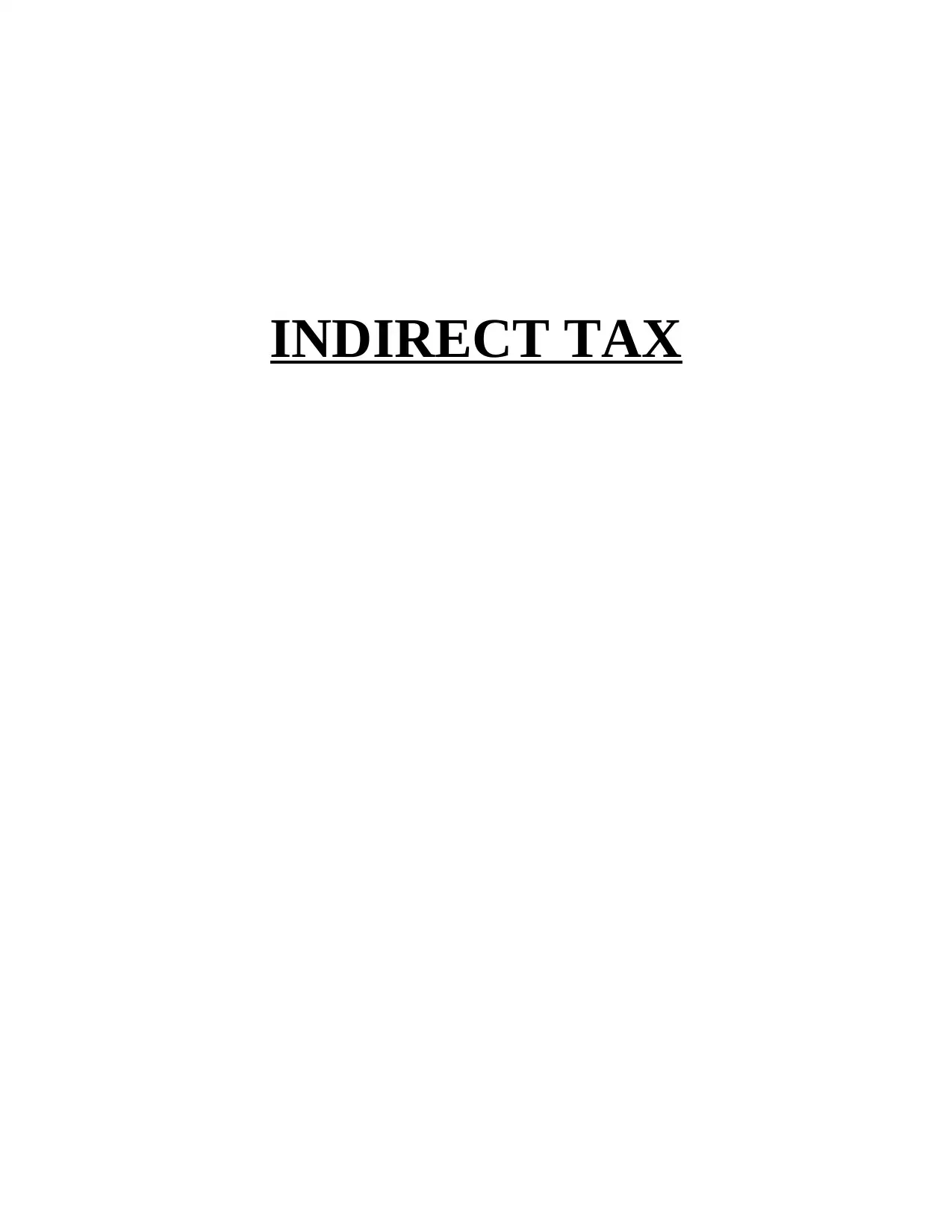
INDIRECT TAX
Secure Best Marks with AI Grader
Need help grading? Try our AI Grader for instant feedback on your assignments.
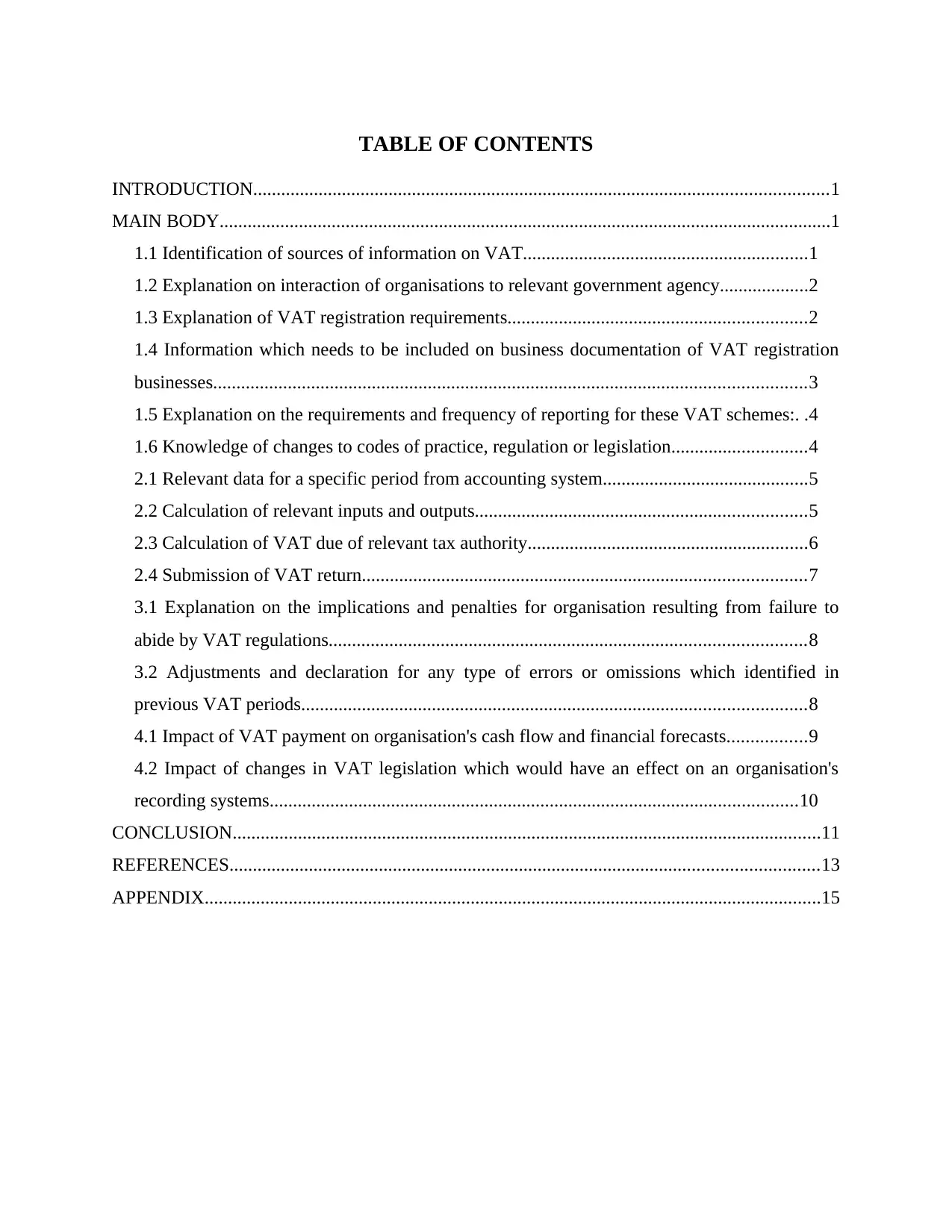
TABLE OF CONTENTS
INTRODUCTION...........................................................................................................................1
MAIN BODY...................................................................................................................................1
1.1 Identification of sources of information on VAT.............................................................1
1.2 Explanation on interaction of organisations to relevant government agency...................2
1.3 Explanation of VAT registration requirements................................................................2
1.4 Information which needs to be included on business documentation of VAT registration
businesses...............................................................................................................................3
1.5 Explanation on the requirements and frequency of reporting for these VAT schemes:. .4
1.6 Knowledge of changes to codes of practice, regulation or legislation.............................4
2.1 Relevant data for a specific period from accounting system............................................5
2.2 Calculation of relevant inputs and outputs.......................................................................5
2.3 Calculation of VAT due of relevant tax authority............................................................6
2.4 Submission of VAT return...............................................................................................7
3.1 Explanation on the implications and penalties for organisation resulting from failure to
abide by VAT regulations......................................................................................................8
3.2 Adjustments and declaration for any type of errors or omissions which identified in
previous VAT periods............................................................................................................8
4.1 Impact of VAT payment on organisation's cash flow and financial forecasts.................9
4.2 Impact of changes in VAT legislation which would have an effect on an organisation's
recording systems.................................................................................................................10
CONCLUSION..............................................................................................................................11
REFERENCES..............................................................................................................................13
APPENDIX....................................................................................................................................15
INTRODUCTION...........................................................................................................................1
MAIN BODY...................................................................................................................................1
1.1 Identification of sources of information on VAT.............................................................1
1.2 Explanation on interaction of organisations to relevant government agency...................2
1.3 Explanation of VAT registration requirements................................................................2
1.4 Information which needs to be included on business documentation of VAT registration
businesses...............................................................................................................................3
1.5 Explanation on the requirements and frequency of reporting for these VAT schemes:. .4
1.6 Knowledge of changes to codes of practice, regulation or legislation.............................4
2.1 Relevant data for a specific period from accounting system............................................5
2.2 Calculation of relevant inputs and outputs.......................................................................5
2.3 Calculation of VAT due of relevant tax authority............................................................6
2.4 Submission of VAT return...............................................................................................7
3.1 Explanation on the implications and penalties for organisation resulting from failure to
abide by VAT regulations......................................................................................................8
3.2 Adjustments and declaration for any type of errors or omissions which identified in
previous VAT periods............................................................................................................8
4.1 Impact of VAT payment on organisation's cash flow and financial forecasts.................9
4.2 Impact of changes in VAT legislation which would have an effect on an organisation's
recording systems.................................................................................................................10
CONCLUSION..............................................................................................................................11
REFERENCES..............................................................................................................................13
APPENDIX....................................................................................................................................15
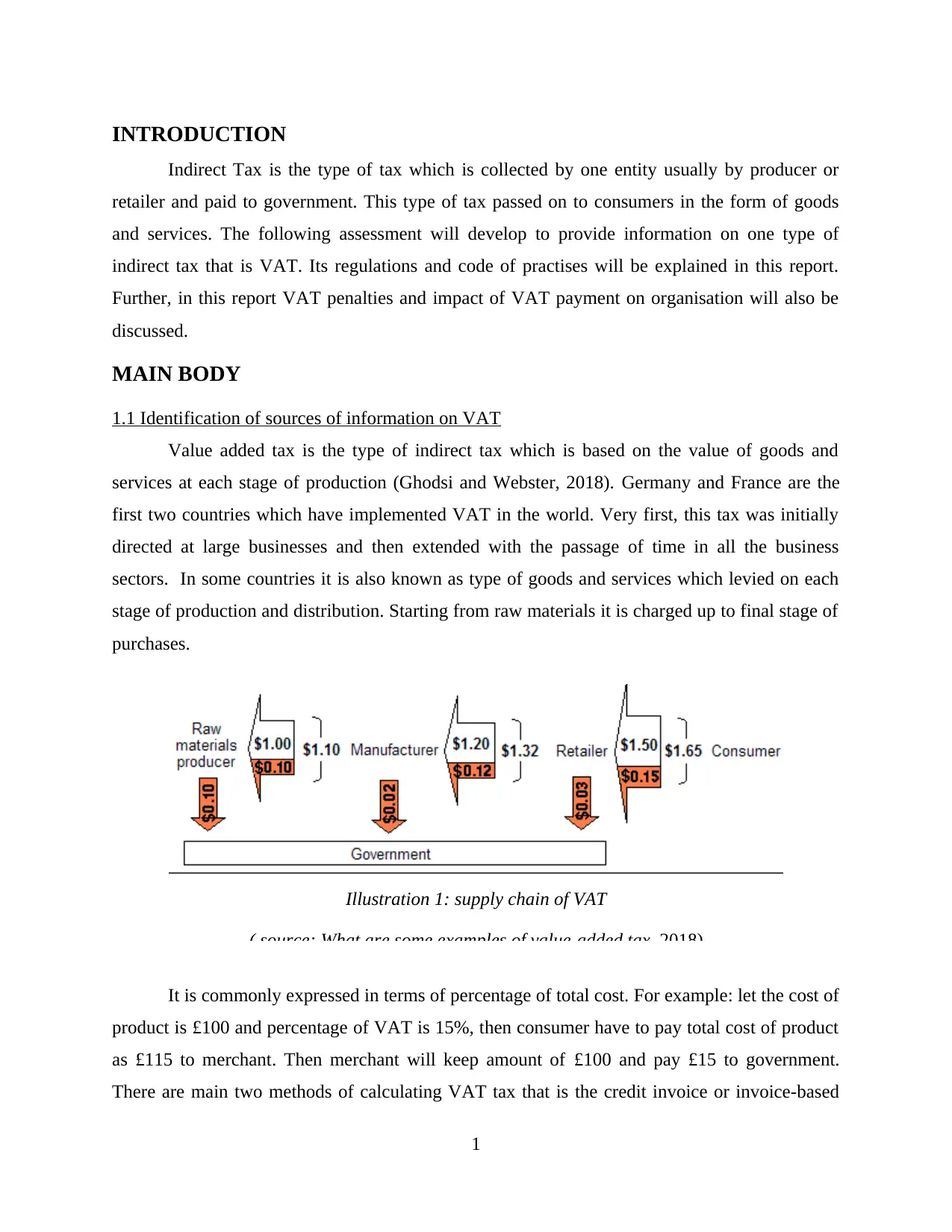
INTRODUCTION
Indirect Tax is the type of tax which is collected by one entity usually by producer or
retailer and paid to government. This type of tax passed on to consumers in the form of goods
and services. The following assessment will develop to provide information on one type of
indirect tax that is VAT. Its regulations and code of practises will be explained in this report.
Further, in this report VAT penalties and impact of VAT payment on organisation will also be
discussed.
MAIN BODY
1.1 Identification of sources of information on VAT
Value added tax is the type of indirect tax which is based on the value of goods and
services at each stage of production (Ghodsi and Webster, 2018). Germany and France are the
first two countries which have implemented VAT in the world. Very first, this tax was initially
directed at large businesses and then extended with the passage of time in all the business
sectors. In some countries it is also known as type of goods and services which levied on each
stage of production and distribution. Starting from raw materials it is charged up to final stage of
purchases.
It is commonly expressed in terms of percentage of total cost. For example: let the cost of
product is £100 and percentage of VAT is 15%, then consumer have to pay total cost of product
as £115 to merchant. Then merchant will keep amount of £100 and pay £15 to government.
There are main two methods of calculating VAT tax that is the credit invoice or invoice-based
1
Illustration 1: supply chain of VAT
( source: What are some examples of value-added tax, 2018)
Indirect Tax is the type of tax which is collected by one entity usually by producer or
retailer and paid to government. This type of tax passed on to consumers in the form of goods
and services. The following assessment will develop to provide information on one type of
indirect tax that is VAT. Its regulations and code of practises will be explained in this report.
Further, in this report VAT penalties and impact of VAT payment on organisation will also be
discussed.
MAIN BODY
1.1 Identification of sources of information on VAT
Value added tax is the type of indirect tax which is based on the value of goods and
services at each stage of production (Ghodsi and Webster, 2018). Germany and France are the
first two countries which have implemented VAT in the world. Very first, this tax was initially
directed at large businesses and then extended with the passage of time in all the business
sectors. In some countries it is also known as type of goods and services which levied on each
stage of production and distribution. Starting from raw materials it is charged up to final stage of
purchases.
It is commonly expressed in terms of percentage of total cost. For example: let the cost of
product is £100 and percentage of VAT is 15%, then consumer have to pay total cost of product
as £115 to merchant. Then merchant will keep amount of £100 and pay £15 to government.
There are main two methods of calculating VAT tax that is the credit invoice or invoice-based
1
Illustration 1: supply chain of VAT
( source: What are some examples of value-added tax, 2018)
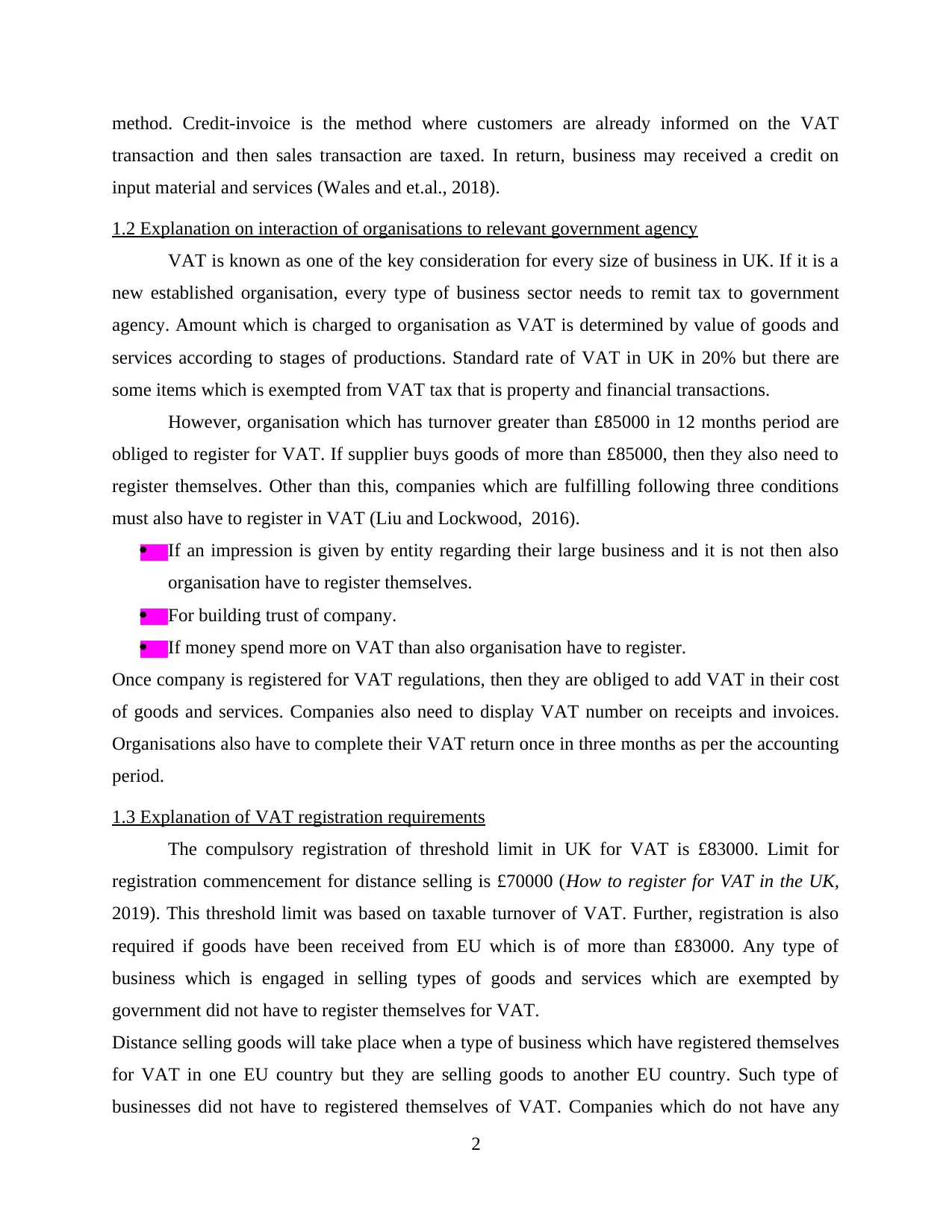
method. Credit-invoice is the method where customers are already informed on the VAT
transaction and then sales transaction are taxed. In return, business may received a credit on
input material and services (Wales and et.al., 2018).
1.2 Explanation on interaction of organisations to relevant government agency
VAT is known as one of the key consideration for every size of business in UK. If it is a
new established organisation, every type of business sector needs to remit tax to government
agency. Amount which is charged to organisation as VAT is determined by value of goods and
services according to stages of productions. Standard rate of VAT in UK in 20% but there are
some items which is exempted from VAT tax that is property and financial transactions.
However, organisation which has turnover greater than £85000 in 12 months period are
obliged to register for VAT. If supplier buys goods of more than £85000, then they also need to
register themselves. Other than this, companies which are fulfilling following three conditions
must also have to register in VAT (Liu and Lockwood, 2016).
If an impression is given by entity regarding their large business and it is not then also
organisation have to register themselves.
For building trust of company.
If money spend more on VAT than also organisation have to register.
Once company is registered for VAT regulations, then they are obliged to add VAT in their cost
of goods and services. Companies also need to display VAT number on receipts and invoices.
Organisations also have to complete their VAT return once in three months as per the accounting
period.
1.3 Explanation of VAT registration requirements
The compulsory registration of threshold limit in UK for VAT is £83000. Limit for
registration commencement for distance selling is £70000 (How to register for VAT in the UK,
2019). This threshold limit was based on taxable turnover of VAT. Further, registration is also
required if goods have been received from EU which is of more than £83000. Any type of
business which is engaged in selling types of goods and services which are exempted by
government did not have to register themselves for VAT.
Distance selling goods will take place when a type of business which have registered themselves
for VAT in one EU country but they are selling goods to another EU country. Such type of
businesses did not have to registered themselves of VAT. Companies which do not have any
2
transaction and then sales transaction are taxed. In return, business may received a credit on
input material and services (Wales and et.al., 2018).
1.2 Explanation on interaction of organisations to relevant government agency
VAT is known as one of the key consideration for every size of business in UK. If it is a
new established organisation, every type of business sector needs to remit tax to government
agency. Amount which is charged to organisation as VAT is determined by value of goods and
services according to stages of productions. Standard rate of VAT in UK in 20% but there are
some items which is exempted from VAT tax that is property and financial transactions.
However, organisation which has turnover greater than £85000 in 12 months period are
obliged to register for VAT. If supplier buys goods of more than £85000, then they also need to
register themselves. Other than this, companies which are fulfilling following three conditions
must also have to register in VAT (Liu and Lockwood, 2016).
If an impression is given by entity regarding their large business and it is not then also
organisation have to register themselves.
For building trust of company.
If money spend more on VAT than also organisation have to register.
Once company is registered for VAT regulations, then they are obliged to add VAT in their cost
of goods and services. Companies also need to display VAT number on receipts and invoices.
Organisations also have to complete their VAT return once in three months as per the accounting
period.
1.3 Explanation of VAT registration requirements
The compulsory registration of threshold limit in UK for VAT is £83000. Limit for
registration commencement for distance selling is £70000 (How to register for VAT in the UK,
2019). This threshold limit was based on taxable turnover of VAT. Further, registration is also
required if goods have been received from EU which is of more than £83000. Any type of
business which is engaged in selling types of goods and services which are exempted by
government did not have to register themselves for VAT.
Distance selling goods will take place when a type of business which have registered themselves
for VAT in one EU country but they are selling goods to another EU country. Such type of
businesses did not have to registered themselves of VAT. Companies which do not have any
2
Secure Best Marks with AI Grader
Need help grading? Try our AI Grader for instant feedback on your assignments.
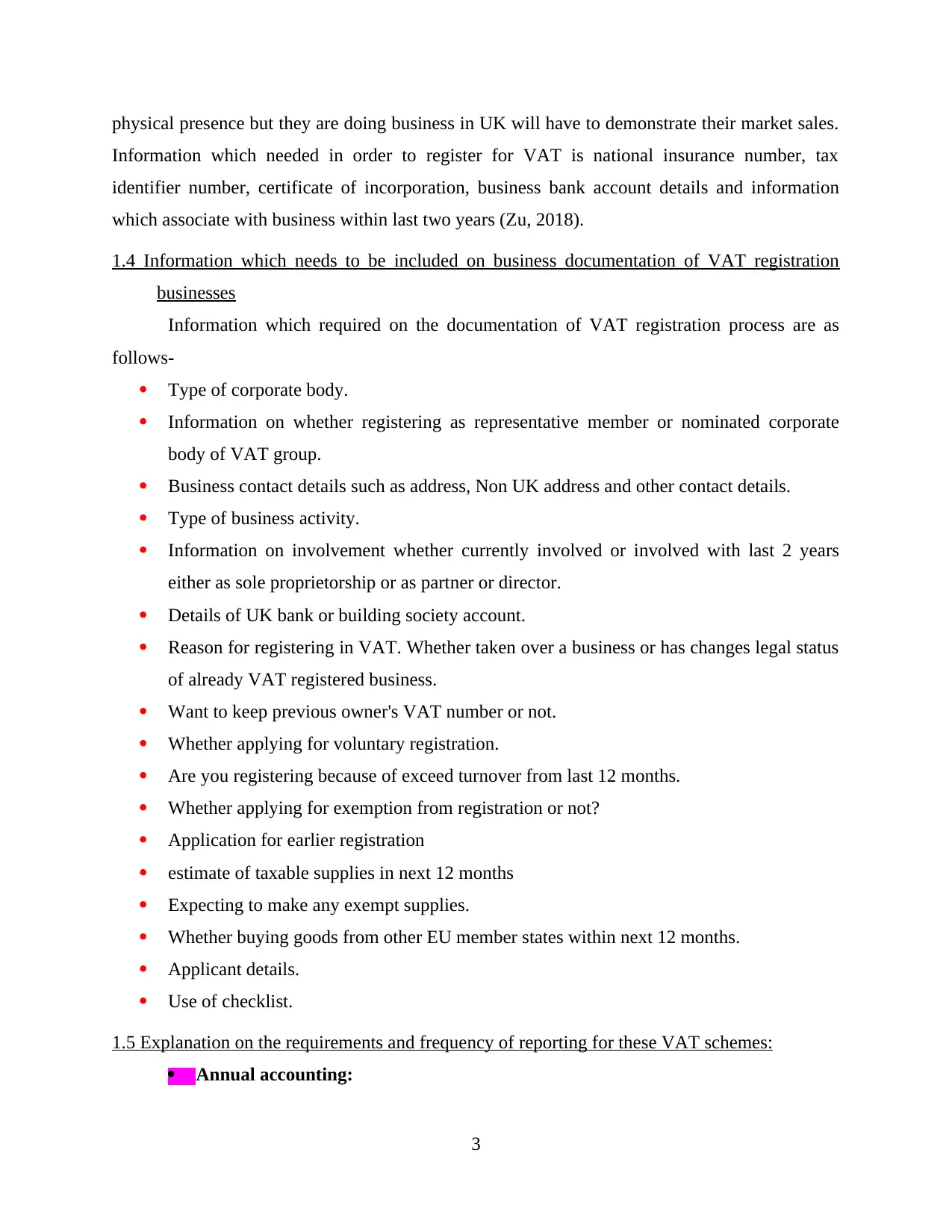
physical presence but they are doing business in UK will have to demonstrate their market sales.
Information which needed in order to register for VAT is national insurance number, tax
identifier number, certificate of incorporation, business bank account details and information
which associate with business within last two years (Zu, 2018).
1.4 Information which needs to be included on business documentation of VAT registration
businesses
Information which required on the documentation of VAT registration process are as
follows-
Type of corporate body.
Information on whether registering as representative member or nominated corporate
body of VAT group.
Business contact details such as address, Non UK address and other contact details.
Type of business activity.
Information on involvement whether currently involved or involved with last 2 years
either as sole proprietorship or as partner or director.
Details of UK bank or building society account.
Reason for registering in VAT. Whether taken over a business or has changes legal status
of already VAT registered business.
Want to keep previous owner's VAT number or not.
Whether applying for voluntary registration.
Are you registering because of exceed turnover from last 12 months.
Whether applying for exemption from registration or not?
Application for earlier registration
estimate of taxable supplies in next 12 months
Expecting to make any exempt supplies.
Whether buying goods from other EU member states within next 12 months.
Applicant details.
Use of checklist.
1.5 Explanation on the requirements and frequency of reporting for these VAT schemes:
Annual accounting:
3
Information which needed in order to register for VAT is national insurance number, tax
identifier number, certificate of incorporation, business bank account details and information
which associate with business within last two years (Zu, 2018).
1.4 Information which needs to be included on business documentation of VAT registration
businesses
Information which required on the documentation of VAT registration process are as
follows-
Type of corporate body.
Information on whether registering as representative member or nominated corporate
body of VAT group.
Business contact details such as address, Non UK address and other contact details.
Type of business activity.
Information on involvement whether currently involved or involved with last 2 years
either as sole proprietorship or as partner or director.
Details of UK bank or building society account.
Reason for registering in VAT. Whether taken over a business or has changes legal status
of already VAT registered business.
Want to keep previous owner's VAT number or not.
Whether applying for voluntary registration.
Are you registering because of exceed turnover from last 12 months.
Whether applying for exemption from registration or not?
Application for earlier registration
estimate of taxable supplies in next 12 months
Expecting to make any exempt supplies.
Whether buying goods from other EU member states within next 12 months.
Applicant details.
Use of checklist.
1.5 Explanation on the requirements and frequency of reporting for these VAT schemes:
Annual accounting:
3

Annual accounting scheme is the type of scheme which allows a person or entity to complete
their VAT return each year (Downing and Langli, 2019). Person or entity which registered under
this scheme have to pay instalments so that they did not have to face with large type of VAT bill
at the end of year. They may choose period of 3 quarter or 9 quarter. Payment of VAT liabilities
must need to pay in direct debit, standing order or with other electronic device.
Cash accounting:
It is the scheme of VAT in which particular method have to follow by registered member in
order to report VAT. This will record on the basis of payment made or received. This scheme
follows principle of cash accounting in which income is recorded when it gets received and
expenses are recorded when get paid.
Flat rate scheme:
This is method which provides a way to business in order to pay VAT (Brusca and et.al., 2015).
With this method, a fixed percentage of annual turnover of business is been paid by its owners.
This scheme designed to simplify VAT return process so that small businesses did not have to
face any problem in order to pay VAT.
Standard scheme:
It is a method of reporting VAT where it is recorded and paid on the basis on invoices which are
issued to entity. With this scheme, businesses submit their VAT return in four times per year.
Any VAT return which gets due will also repay quarterly.
1.6 Knowledge of changes to codes of practice, regulation or legislation
Update code of practises in accordance with regulation or legislation are as follows-
HMRC body of UK has brought some changes with Notice 700 for VAT regulation. This notice
will provide guide to all the main VAT rules and procedures (Obeng, 2018). This notice will also
help in solving problems which is faced by the bushiness. Changes are implemented in paragraph
8.3 and 8.14 in previous notice of VAT.
VAT Notice 700/12 will guide businesses in order to filling and submitting their VAT
returns and VAT Notice 700/21 will help then in keeping records of VAT. Legislation of VAT
bodies also brought a retail scheme for people who are engaged in business of retail sale to
public. If businesses involved in business within EU then they have to take proper guide from
VAT Notice 725 which is known for single market. Businesses which involved in supply of
4
their VAT return each year (Downing and Langli, 2019). Person or entity which registered under
this scheme have to pay instalments so that they did not have to face with large type of VAT bill
at the end of year. They may choose period of 3 quarter or 9 quarter. Payment of VAT liabilities
must need to pay in direct debit, standing order or with other electronic device.
Cash accounting:
It is the scheme of VAT in which particular method have to follow by registered member in
order to report VAT. This will record on the basis of payment made or received. This scheme
follows principle of cash accounting in which income is recorded when it gets received and
expenses are recorded when get paid.
Flat rate scheme:
This is method which provides a way to business in order to pay VAT (Brusca and et.al., 2015).
With this method, a fixed percentage of annual turnover of business is been paid by its owners.
This scheme designed to simplify VAT return process so that small businesses did not have to
face any problem in order to pay VAT.
Standard scheme:
It is a method of reporting VAT where it is recorded and paid on the basis on invoices which are
issued to entity. With this scheme, businesses submit their VAT return in four times per year.
Any VAT return which gets due will also repay quarterly.
1.6 Knowledge of changes to codes of practice, regulation or legislation
Update code of practises in accordance with regulation or legislation are as follows-
HMRC body of UK has brought some changes with Notice 700 for VAT regulation. This notice
will provide guide to all the main VAT rules and procedures (Obeng, 2018). This notice will also
help in solving problems which is faced by the bushiness. Changes are implemented in paragraph
8.3 and 8.14 in previous notice of VAT.
VAT Notice 700/12 will guide businesses in order to filling and submitting their VAT
returns and VAT Notice 700/21 will help then in keeping records of VAT. Legislation of VAT
bodies also brought a retail scheme for people who are engaged in business of retail sale to
public. If businesses involved in business within EU then they have to take proper guide from
VAT Notice 725 which is known for single market. Businesses which involved in supply of
4
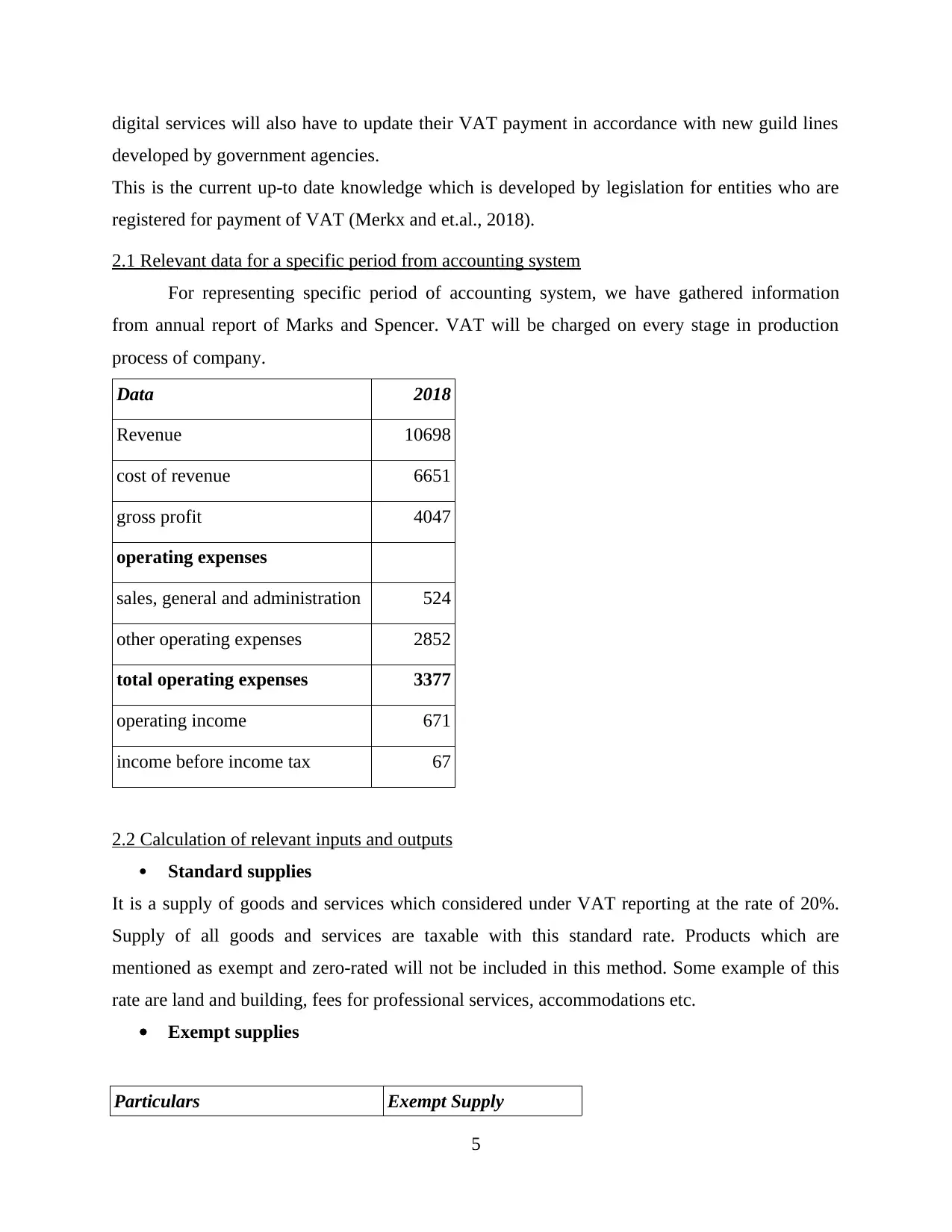
digital services will also have to update their VAT payment in accordance with new guild lines
developed by government agencies.
This is the current up-to date knowledge which is developed by legislation for entities who are
registered for payment of VAT (Merkx and et.al., 2018).
2.1 Relevant data for a specific period from accounting system
For representing specific period of accounting system, we have gathered information
from annual report of Marks and Spencer. VAT will be charged on every stage in production
process of company.
Data 2018
Revenue 10698
cost of revenue 6651
gross profit 4047
operating expenses
sales, general and administration 524
other operating expenses 2852
total operating expenses 3377
operating income 671
income before income tax 67
2.2 Calculation of relevant inputs and outputs
Standard supplies
It is a supply of goods and services which considered under VAT reporting at the rate of 20%.
Supply of all goods and services are taxable with this standard rate. Products which are
mentioned as exempt and zero-rated will not be included in this method. Some example of this
rate are land and building, fees for professional services, accommodations etc.
Exempt supplies
Particulars Exempt Supply
5
developed by government agencies.
This is the current up-to date knowledge which is developed by legislation for entities who are
registered for payment of VAT (Merkx and et.al., 2018).
2.1 Relevant data for a specific period from accounting system
For representing specific period of accounting system, we have gathered information
from annual report of Marks and Spencer. VAT will be charged on every stage in production
process of company.
Data 2018
Revenue 10698
cost of revenue 6651
gross profit 4047
operating expenses
sales, general and administration 524
other operating expenses 2852
total operating expenses 3377
operating income 671
income before income tax 67
2.2 Calculation of relevant inputs and outputs
Standard supplies
It is a supply of goods and services which considered under VAT reporting at the rate of 20%.
Supply of all goods and services are taxable with this standard rate. Products which are
mentioned as exempt and zero-rated will not be included in this method. Some example of this
rate are land and building, fees for professional services, accommodations etc.
Exempt supplies
Particulars Exempt Supply
5
Paraphrase This Document
Need a fresh take? Get an instant paraphrase of this document with our AI Paraphraser
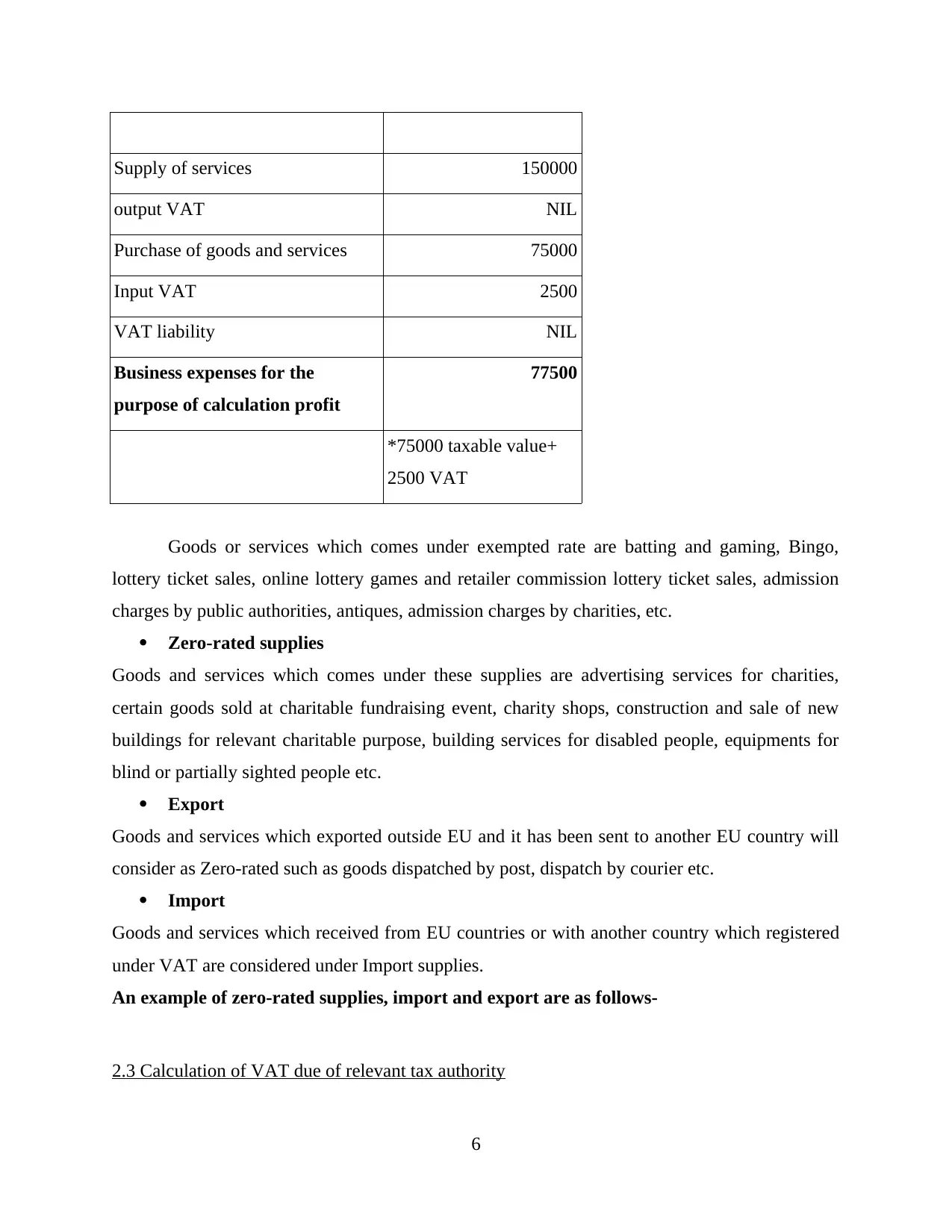
Supply of services 150000
output VAT NIL
Purchase of goods and services 75000
Input VAT 2500
VAT liability NIL
Business expenses for the
purpose of calculation profit
77500
*75000 taxable value+
2500 VAT
Goods or services which comes under exempted rate are batting and gaming, Bingo,
lottery ticket sales, online lottery games and retailer commission lottery ticket sales, admission
charges by public authorities, antiques, admission charges by charities, etc.
Zero-rated supplies
Goods and services which comes under these supplies are advertising services for charities,
certain goods sold at charitable fundraising event, charity shops, construction and sale of new
buildings for relevant charitable purpose, building services for disabled people, equipments for
blind or partially sighted people etc.
Export
Goods and services which exported outside EU and it has been sent to another EU country will
consider as Zero-rated such as goods dispatched by post, dispatch by courier etc.
Import
Goods and services which received from EU countries or with another country which registered
under VAT are considered under Import supplies.
An example of zero-rated supplies, import and export are as follows-
2.3 Calculation of VAT due of relevant tax authority
6
output VAT NIL
Purchase of goods and services 75000
Input VAT 2500
VAT liability NIL
Business expenses for the
purpose of calculation profit
77500
*75000 taxable value+
2500 VAT
Goods or services which comes under exempted rate are batting and gaming, Bingo,
lottery ticket sales, online lottery games and retailer commission lottery ticket sales, admission
charges by public authorities, antiques, admission charges by charities, etc.
Zero-rated supplies
Goods and services which comes under these supplies are advertising services for charities,
certain goods sold at charitable fundraising event, charity shops, construction and sale of new
buildings for relevant charitable purpose, building services for disabled people, equipments for
blind or partially sighted people etc.
Export
Goods and services which exported outside EU and it has been sent to another EU country will
consider as Zero-rated such as goods dispatched by post, dispatch by courier etc.
Import
Goods and services which received from EU countries or with another country which registered
under VAT are considered under Import supplies.
An example of zero-rated supplies, import and export are as follows-
2.3 Calculation of VAT due of relevant tax authority
6

Standard VAT scheme Flat rate VAT scheme
sales of Marks & Spencer 10698 10698
vate at 20% 2139.6 2139.6
sales incl. vat 12837.6 12837.6
VAT on cost 1330.2
Falte rate% (assumed 10%) 1283.76
VAT due to HMRC 14167.8 1283.76
Gain on Flat rate scheme 12884.04
Particulars Details VAT
rates
Sales revenue 30000 20%
fuel expenses 1000 5%
food and beverages 1200 0%
Education (university fess) 500 Exempted
Substantial reconstruction 750 0%
Garage and parking expenses 800 Exempted
Clothing expenses 900 0%
Occupation of land 1500 Exempted
Transportation charges 1200 0%
Import of goods 400 10%
Export of material 600 20%
2.4 Submission of VAT return
Particulars Details VAT Amount
7
sales of Marks & Spencer 10698 10698
vate at 20% 2139.6 2139.6
sales incl. vat 12837.6 12837.6
VAT on cost 1330.2
Falte rate% (assumed 10%) 1283.76
VAT due to HMRC 14167.8 1283.76
Gain on Flat rate scheme 12884.04
Particulars Details VAT
rates
Sales revenue 30000 20%
fuel expenses 1000 5%
food and beverages 1200 0%
Education (university fess) 500 Exempted
Substantial reconstruction 750 0%
Garage and parking expenses 800 Exempted
Clothing expenses 900 0%
Occupation of land 1500 Exempted
Transportation charges 1200 0%
Import of goods 400 10%
Export of material 600 20%
2.4 Submission of VAT return
Particulars Details VAT Amount
7
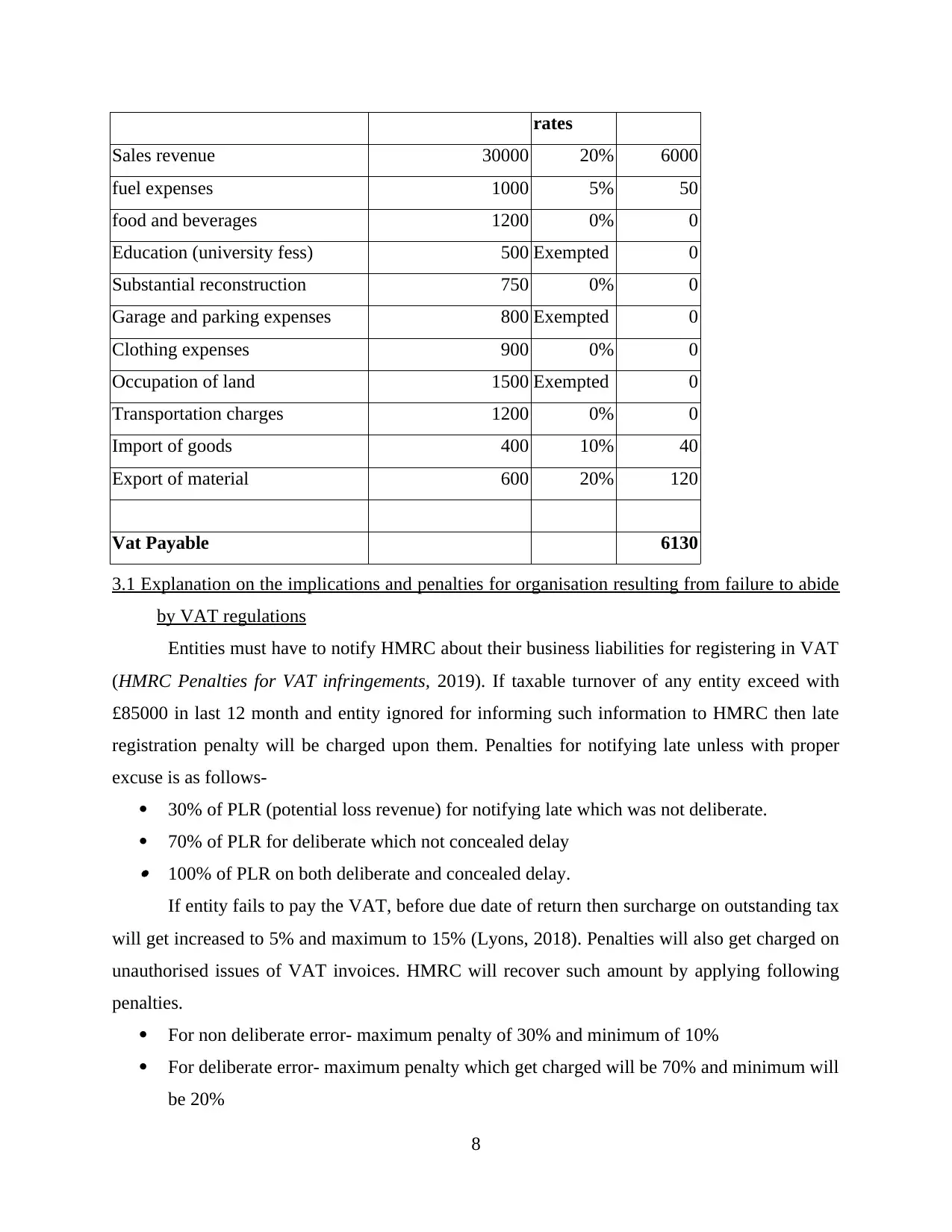
rates
Sales revenue 30000 20% 6000
fuel expenses 1000 5% 50
food and beverages 1200 0% 0
Education (university fess) 500 Exempted 0
Substantial reconstruction 750 0% 0
Garage and parking expenses 800 Exempted 0
Clothing expenses 900 0% 0
Occupation of land 1500 Exempted 0
Transportation charges 1200 0% 0
Import of goods 400 10% 40
Export of material 600 20% 120
Vat Payable 6130
3.1 Explanation on the implications and penalties for organisation resulting from failure to abide
by VAT regulations
Entities must have to notify HMRC about their business liabilities for registering in VAT
(HMRC Penalties for VAT infringements, 2019). If taxable turnover of any entity exceed with
£85000 in last 12 month and entity ignored for informing such information to HMRC then late
registration penalty will be charged upon them. Penalties for notifying late unless with proper
excuse is as follows-
30% of PLR (potential loss revenue) for notifying late which was not deliberate.
70% of PLR for deliberate which not concealed delay 100% of PLR on both deliberate and concealed delay.
If entity fails to pay the VAT, before due date of return then surcharge on outstanding tax
will get increased to 5% and maximum to 15% (Lyons, 2018). Penalties will also get charged on
unauthorised issues of VAT invoices. HMRC will recover such amount by applying following
penalties.
For non deliberate error- maximum penalty of 30% and minimum of 10%
For deliberate error- maximum penalty which get charged will be 70% and minimum will
be 20%
8
Sales revenue 30000 20% 6000
fuel expenses 1000 5% 50
food and beverages 1200 0% 0
Education (university fess) 500 Exempted 0
Substantial reconstruction 750 0% 0
Garage and parking expenses 800 Exempted 0
Clothing expenses 900 0% 0
Occupation of land 1500 Exempted 0
Transportation charges 1200 0% 0
Import of goods 400 10% 40
Export of material 600 20% 120
Vat Payable 6130
3.1 Explanation on the implications and penalties for organisation resulting from failure to abide
by VAT regulations
Entities must have to notify HMRC about their business liabilities for registering in VAT
(HMRC Penalties for VAT infringements, 2019). If taxable turnover of any entity exceed with
£85000 in last 12 month and entity ignored for informing such information to HMRC then late
registration penalty will be charged upon them. Penalties for notifying late unless with proper
excuse is as follows-
30% of PLR (potential loss revenue) for notifying late which was not deliberate.
70% of PLR for deliberate which not concealed delay 100% of PLR on both deliberate and concealed delay.
If entity fails to pay the VAT, before due date of return then surcharge on outstanding tax
will get increased to 5% and maximum to 15% (Lyons, 2018). Penalties will also get charged on
unauthorised issues of VAT invoices. HMRC will recover such amount by applying following
penalties.
For non deliberate error- maximum penalty of 30% and minimum of 10%
For deliberate error- maximum penalty which get charged will be 70% and minimum will
be 20%
8
Secure Best Marks with AI Grader
Need help grading? Try our AI Grader for instant feedback on your assignments.
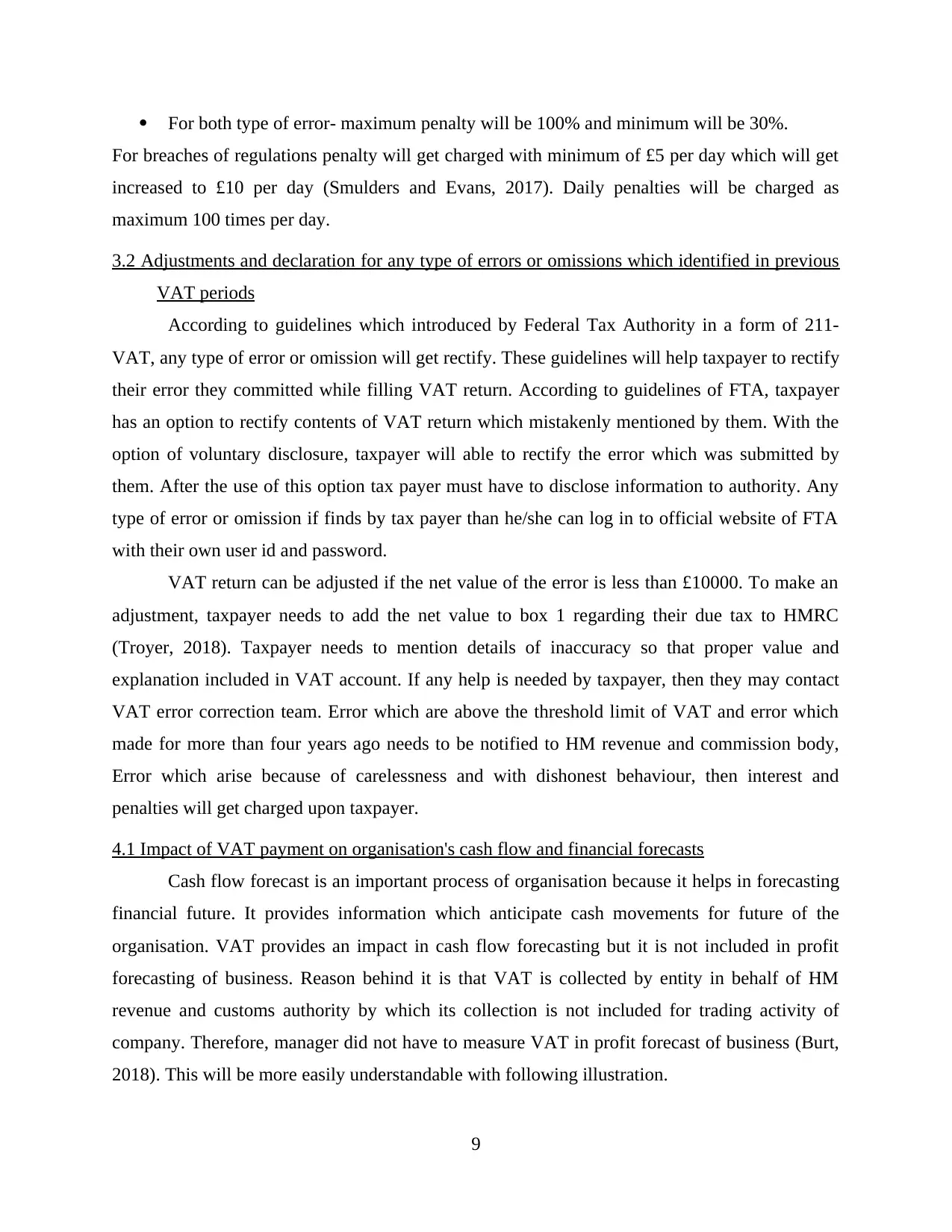
For both type of error- maximum penalty will be 100% and minimum will be 30%.
For breaches of regulations penalty will get charged with minimum of £5 per day which will get
increased to £10 per day (Smulders and Evans, 2017). Daily penalties will be charged as
maximum 100 times per day.
3.2 Adjustments and declaration for any type of errors or omissions which identified in previous
VAT periods
According to guidelines which introduced by Federal Tax Authority in a form of 211-
VAT, any type of error or omission will get rectify. These guidelines will help taxpayer to rectify
their error they committed while filling VAT return. According to guidelines of FTA, taxpayer
has an option to rectify contents of VAT return which mistakenly mentioned by them. With the
option of voluntary disclosure, taxpayer will able to rectify the error which was submitted by
them. After the use of this option tax payer must have to disclose information to authority. Any
type of error or omission if finds by tax payer than he/she can log in to official website of FTA
with their own user id and password.
VAT return can be adjusted if the net value of the error is less than £10000. To make an
adjustment, taxpayer needs to add the net value to box 1 regarding their due tax to HMRC
(Troyer, 2018). Taxpayer needs to mention details of inaccuracy so that proper value and
explanation included in VAT account. If any help is needed by taxpayer, then they may contact
VAT error correction team. Error which are above the threshold limit of VAT and error which
made for more than four years ago needs to be notified to HM revenue and commission body,
Error which arise because of carelessness and with dishonest behaviour, then interest and
penalties will get charged upon taxpayer.
4.1 Impact of VAT payment on organisation's cash flow and financial forecasts
Cash flow forecast is an important process of organisation because it helps in forecasting
financial future. It provides information which anticipate cash movements for future of the
organisation. VAT provides an impact in cash flow forecasting but it is not included in profit
forecasting of business. Reason behind it is that VAT is collected by entity in behalf of HM
revenue and customs authority by which its collection is not included for trading activity of
company. Therefore, manager did not have to measure VAT in profit forecast of business (Burt,
2018). This will be more easily understandable with following illustration.
9
For breaches of regulations penalty will get charged with minimum of £5 per day which will get
increased to £10 per day (Smulders and Evans, 2017). Daily penalties will be charged as
maximum 100 times per day.
3.2 Adjustments and declaration for any type of errors or omissions which identified in previous
VAT periods
According to guidelines which introduced by Federal Tax Authority in a form of 211-
VAT, any type of error or omission will get rectify. These guidelines will help taxpayer to rectify
their error they committed while filling VAT return. According to guidelines of FTA, taxpayer
has an option to rectify contents of VAT return which mistakenly mentioned by them. With the
option of voluntary disclosure, taxpayer will able to rectify the error which was submitted by
them. After the use of this option tax payer must have to disclose information to authority. Any
type of error or omission if finds by tax payer than he/she can log in to official website of FTA
with their own user id and password.
VAT return can be adjusted if the net value of the error is less than £10000. To make an
adjustment, taxpayer needs to add the net value to box 1 regarding their due tax to HMRC
(Troyer, 2018). Taxpayer needs to mention details of inaccuracy so that proper value and
explanation included in VAT account. If any help is needed by taxpayer, then they may contact
VAT error correction team. Error which are above the threshold limit of VAT and error which
made for more than four years ago needs to be notified to HM revenue and commission body,
Error which arise because of carelessness and with dishonest behaviour, then interest and
penalties will get charged upon taxpayer.
4.1 Impact of VAT payment on organisation's cash flow and financial forecasts
Cash flow forecast is an important process of organisation because it helps in forecasting
financial future. It provides information which anticipate cash movements for future of the
organisation. VAT provides an impact in cash flow forecasting but it is not included in profit
forecasting of business. Reason behind it is that VAT is collected by entity in behalf of HM
revenue and customs authority by which its collection is not included for trading activity of
company. Therefore, manager did not have to measure VAT in profit forecast of business (Burt,
2018). This will be more easily understandable with following illustration.
9
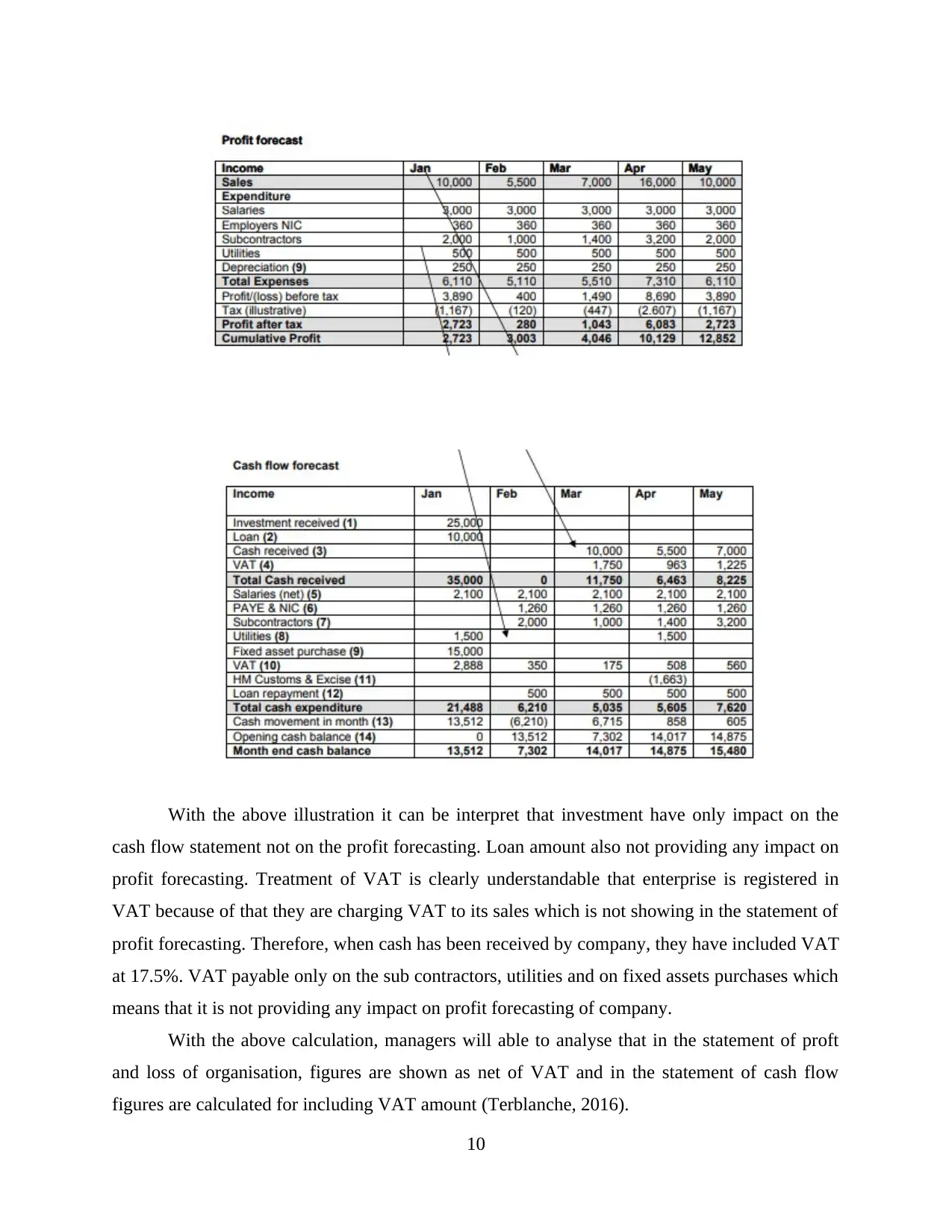
With the above illustration it can be interpret that investment have only impact on the
cash flow statement not on the profit forecasting. Loan amount also not providing any impact on
profit forecasting. Treatment of VAT is clearly understandable that enterprise is registered in
VAT because of that they are charging VAT to its sales which is not showing in the statement of
profit forecasting. Therefore, when cash has been received by company, they have included VAT
at 17.5%. VAT payable only on the sub contractors, utilities and on fixed assets purchases which
means that it is not providing any impact on profit forecasting of company.
With the above calculation, managers will able to analyse that in the statement of proft
and loss of organisation, figures are shown as net of VAT and in the statement of cash flow
figures are calculated for including VAT amount (Terblanche, 2016).
10
cash flow statement not on the profit forecasting. Loan amount also not providing any impact on
profit forecasting. Treatment of VAT is clearly understandable that enterprise is registered in
VAT because of that they are charging VAT to its sales which is not showing in the statement of
profit forecasting. Therefore, when cash has been received by company, they have included VAT
at 17.5%. VAT payable only on the sub contractors, utilities and on fixed assets purchases which
means that it is not providing any impact on profit forecasting of company.
With the above calculation, managers will able to analyse that in the statement of proft
and loss of organisation, figures are shown as net of VAT and in the statement of cash flow
figures are calculated for including VAT amount (Terblanche, 2016).
10
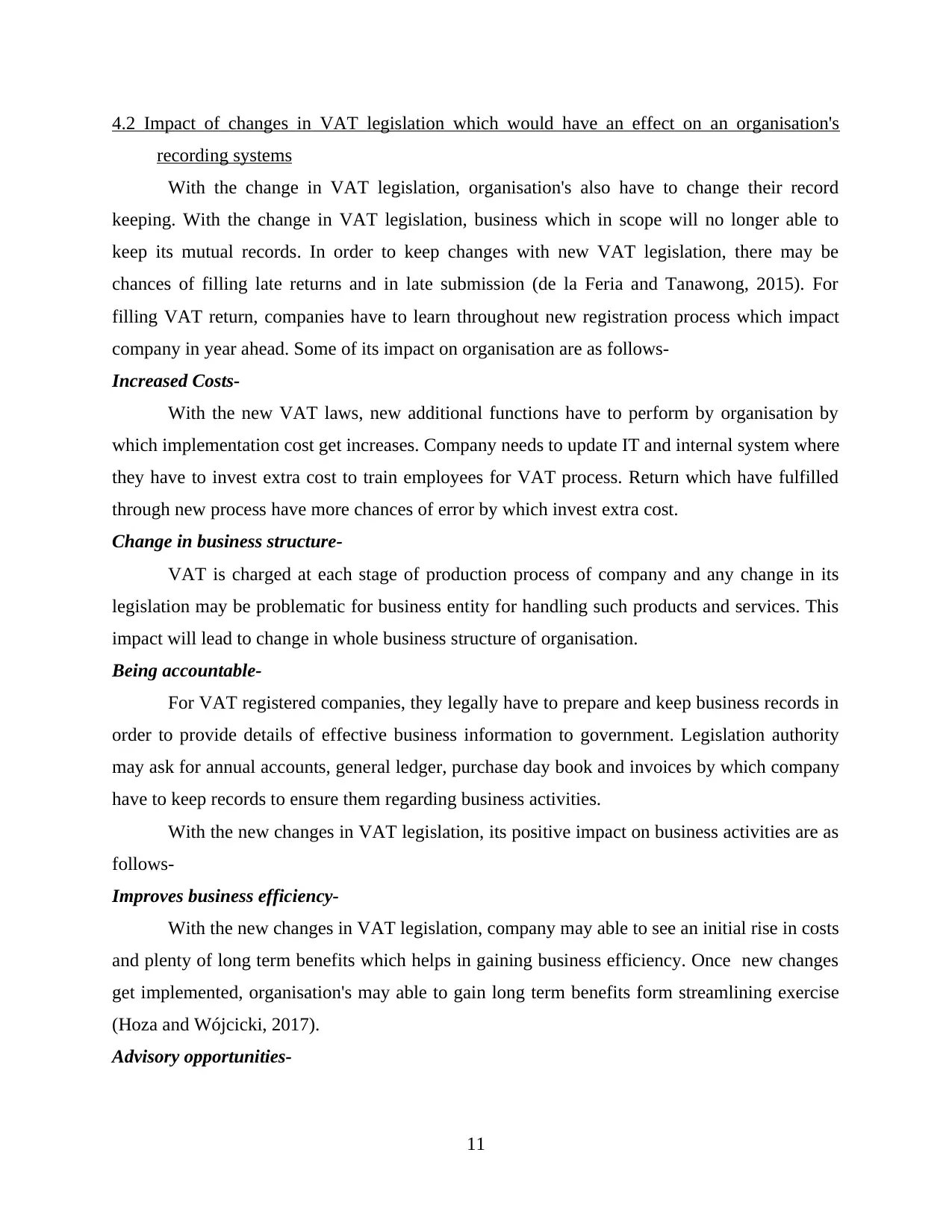
4.2 Impact of changes in VAT legislation which would have an effect on an organisation's
recording systems
With the change in VAT legislation, organisation's also have to change their record
keeping. With the change in VAT legislation, business which in scope will no longer able to
keep its mutual records. In order to keep changes with new VAT legislation, there may be
chances of filling late returns and in late submission (de la Feria and Tanawong, 2015). For
filling VAT return, companies have to learn throughout new registration process which impact
company in year ahead. Some of its impact on organisation are as follows-
Increased Costs-
With the new VAT laws, new additional functions have to perform by organisation by
which implementation cost get increases. Company needs to update IT and internal system where
they have to invest extra cost to train employees for VAT process. Return which have fulfilled
through new process have more chances of error by which invest extra cost.
Change in business structure-
VAT is charged at each stage of production process of company and any change in its
legislation may be problematic for business entity for handling such products and services. This
impact will lead to change in whole business structure of organisation.
Being accountable-
For VAT registered companies, they legally have to prepare and keep business records in
order to provide details of effective business information to government. Legislation authority
may ask for annual accounts, general ledger, purchase day book and invoices by which company
have to keep records to ensure them regarding business activities.
With the new changes in VAT legislation, its positive impact on business activities are as
follows-
Improves business efficiency-
With the new changes in VAT legislation, company may able to see an initial rise in costs
and plenty of long term benefits which helps in gaining business efficiency. Once new changes
get implemented, organisation's may able to gain long term benefits form streamlining exercise
(Hoza and Wójcicki, 2017).
Advisory opportunities-
11
recording systems
With the change in VAT legislation, organisation's also have to change their record
keeping. With the change in VAT legislation, business which in scope will no longer able to
keep its mutual records. In order to keep changes with new VAT legislation, there may be
chances of filling late returns and in late submission (de la Feria and Tanawong, 2015). For
filling VAT return, companies have to learn throughout new registration process which impact
company in year ahead. Some of its impact on organisation are as follows-
Increased Costs-
With the new VAT laws, new additional functions have to perform by organisation by
which implementation cost get increases. Company needs to update IT and internal system where
they have to invest extra cost to train employees for VAT process. Return which have fulfilled
through new process have more chances of error by which invest extra cost.
Change in business structure-
VAT is charged at each stage of production process of company and any change in its
legislation may be problematic for business entity for handling such products and services. This
impact will lead to change in whole business structure of organisation.
Being accountable-
For VAT registered companies, they legally have to prepare and keep business records in
order to provide details of effective business information to government. Legislation authority
may ask for annual accounts, general ledger, purchase day book and invoices by which company
have to keep records to ensure them regarding business activities.
With the new changes in VAT legislation, its positive impact on business activities are as
follows-
Improves business efficiency-
With the new changes in VAT legislation, company may able to see an initial rise in costs
and plenty of long term benefits which helps in gaining business efficiency. Once new changes
get implemented, organisation's may able to gain long term benefits form streamlining exercise
(Hoza and Wójcicki, 2017).
Advisory opportunities-
11
Paraphrase This Document
Need a fresh take? Get an instant paraphrase of this document with our AI Paraphraser
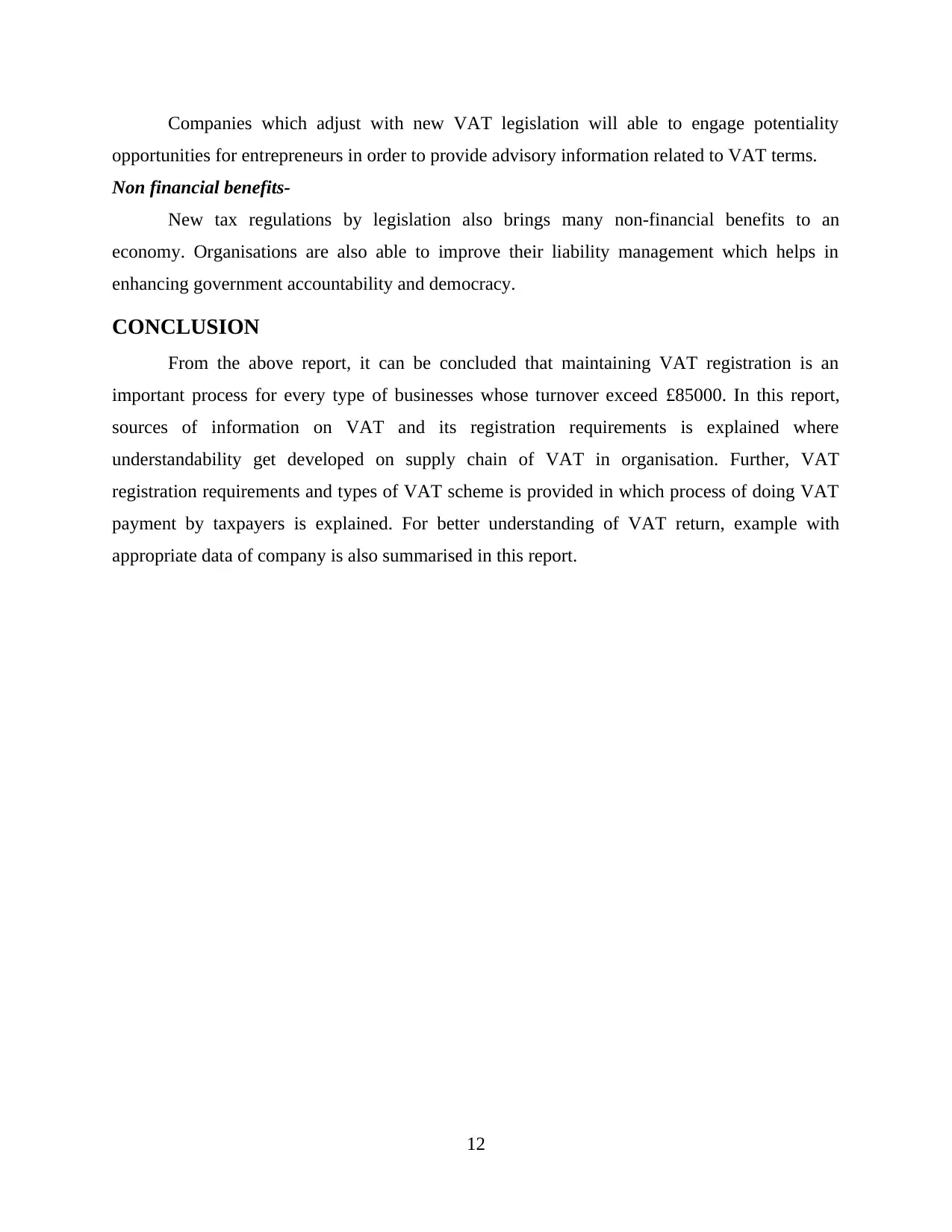
Companies which adjust with new VAT legislation will able to engage potentiality
opportunities for entrepreneurs in order to provide advisory information related to VAT terms.
Non financial benefits-
New tax regulations by legislation also brings many non-financial benefits to an
economy. Organisations are also able to improve their liability management which helps in
enhancing government accountability and democracy.
CONCLUSION
From the above report, it can be concluded that maintaining VAT registration is an
important process for every type of businesses whose turnover exceed £85000. In this report,
sources of information on VAT and its registration requirements is explained where
understandability get developed on supply chain of VAT in organisation. Further, VAT
registration requirements and types of VAT scheme is provided in which process of doing VAT
payment by taxpayers is explained. For better understanding of VAT return, example with
appropriate data of company is also summarised in this report.
12
opportunities for entrepreneurs in order to provide advisory information related to VAT terms.
Non financial benefits-
New tax regulations by legislation also brings many non-financial benefits to an
economy. Organisations are also able to improve their liability management which helps in
enhancing government accountability and democracy.
CONCLUSION
From the above report, it can be concluded that maintaining VAT registration is an
important process for every type of businesses whose turnover exceed £85000. In this report,
sources of information on VAT and its registration requirements is explained where
understandability get developed on supply chain of VAT in organisation. Further, VAT
registration requirements and types of VAT scheme is provided in which process of doing VAT
payment by taxpayers is explained. For better understanding of VAT return, example with
appropriate data of company is also summarised in this report.
12

REFERENCES
Books and Journals
Brusca, I and et.al., 2015. Comparing accounting systems in Europe. In Public Sector
Accounting and Auditing in Europe (pp. 235-251). Palgrave Macmillan, London.
Burt, K., 2018. Imposing understatement penalties: adopting the right
approach. TAXtalk. 2018(70). pp.48-51.
de la Feria, R. and Tanawong, P., 2015. Surcharges and penalties in UK tax law.
Downing, J. and Langli, J.C., 2019. Audit exemptions and compliance with tax and accounting
regulations. Accounting and Business Research. 49(1). pp.28-67.
Ghodsi, Z. and Webster, A., 2018. UK Taxes and Tax Revenues: Composition and Trends.
Hoza, B. and Wójcicki, M., 2017. Vat Fraud Prevention. Zeszyty Naukowe Wyższej Szkoły
Finansów i Prawa w Bielsku-Białej. (2). pp.44-58.
Liu, L. and Lockwood, B., 2016. VAT notches, voluntary registration and bunching: Theory and
UK evidence.
Lyons, T., 2018. UK Customs Penalties and EU Harmonization. Global Trade and Customs
Journal. 13(7). pp.347-353.
Merkx, M and et.al., 2018. Definitive VAT Regime: Stairway to Heaven or Highway to
Hell?. EC Tax Review. 27(2). pp.74-82.
Obeng, G., 2018. Value Added Tax and Vat Flat Rate Scheme in Ghana, Any Cascading
Implications. Asian Development Policy Review. 6(4). pp.213-225.
Smulders, S. and Evans, C., 2017. Mitigating VAT compliance costs-A developing country
perspective. In Australian Tax Forum (Vol. 32, No. 2, p. 283). Tax Institute.
Terblanche, V., 2016. VAT year in review: the value adds & the value fads. TAXtalk. 2016(61).
pp.48-51.
Troyer, I.D., 2018. Interest on VAT Claims. EC Tax Review. 27(2). pp.83-95.
Wales, P and et.al., 2018. UK trade in goods and productivity: New findings (No. ESCoE DP-
2018-09). Economic Statistics Centre of Excellence (ESCoE).
Zu, Y., 2018. VAT/GST Thresholds and Small Businesses: Where to Draw the Line?.
Online
13
Books and Journals
Brusca, I and et.al., 2015. Comparing accounting systems in Europe. In Public Sector
Accounting and Auditing in Europe (pp. 235-251). Palgrave Macmillan, London.
Burt, K., 2018. Imposing understatement penalties: adopting the right
approach. TAXtalk. 2018(70). pp.48-51.
de la Feria, R. and Tanawong, P., 2015. Surcharges and penalties in UK tax law.
Downing, J. and Langli, J.C., 2019. Audit exemptions and compliance with tax and accounting
regulations. Accounting and Business Research. 49(1). pp.28-67.
Ghodsi, Z. and Webster, A., 2018. UK Taxes and Tax Revenues: Composition and Trends.
Hoza, B. and Wójcicki, M., 2017. Vat Fraud Prevention. Zeszyty Naukowe Wyższej Szkoły
Finansów i Prawa w Bielsku-Białej. (2). pp.44-58.
Liu, L. and Lockwood, B., 2016. VAT notches, voluntary registration and bunching: Theory and
UK evidence.
Lyons, T., 2018. UK Customs Penalties and EU Harmonization. Global Trade and Customs
Journal. 13(7). pp.347-353.
Merkx, M and et.al., 2018. Definitive VAT Regime: Stairway to Heaven or Highway to
Hell?. EC Tax Review. 27(2). pp.74-82.
Obeng, G., 2018. Value Added Tax and Vat Flat Rate Scheme in Ghana, Any Cascading
Implications. Asian Development Policy Review. 6(4). pp.213-225.
Smulders, S. and Evans, C., 2017. Mitigating VAT compliance costs-A developing country
perspective. In Australian Tax Forum (Vol. 32, No. 2, p. 283). Tax Institute.
Terblanche, V., 2016. VAT year in review: the value adds & the value fads. TAXtalk. 2016(61).
pp.48-51.
Troyer, I.D., 2018. Interest on VAT Claims. EC Tax Review. 27(2). pp.83-95.
Wales, P and et.al., 2018. UK trade in goods and productivity: New findings (No. ESCoE DP-
2018-09). Economic Statistics Centre of Excellence (ESCoE).
Zu, Y., 2018. VAT/GST Thresholds and Small Businesses: Where to Draw the Line?.
Online
13

HMRC Penalties for VAT infringements. 2019. [Online]. Available through
<https://www.plummer-parsons.co.uk/taxation-services/business-tax/value-added-tax-vat/
penalties-vat-infringements>
How to register for VAT in the UK. 2019. [Online]. Available through
<https://1office.co/blog/register-vat-uk/>
Maverick, J.B., 2018. What are some examples of value added tax. [Online]. Available through
<https://www.investopedia.com/ask/answers/042315/what-are-some-examples-value-
added-tax.asp>
14
<https://www.plummer-parsons.co.uk/taxation-services/business-tax/value-added-tax-vat/
penalties-vat-infringements>
How to register for VAT in the UK. 2019. [Online]. Available through
<https://1office.co/blog/register-vat-uk/>
Maverick, J.B., 2018. What are some examples of value added tax. [Online]. Available through
<https://www.investopedia.com/ask/answers/042315/what-are-some-examples-value-
added-tax.asp>
14
Secure Best Marks with AI Grader
Need help grading? Try our AI Grader for instant feedback on your assignments.
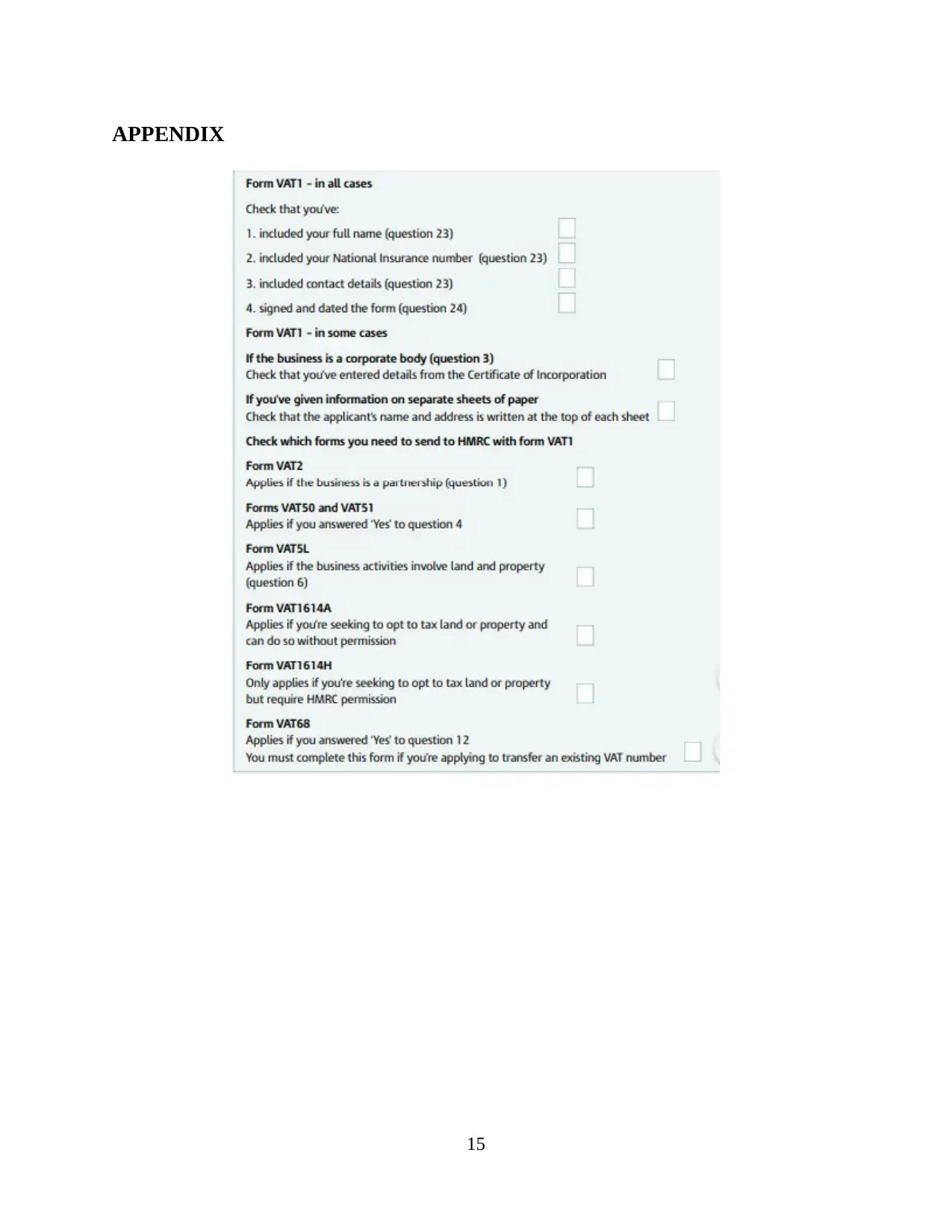
APPENDIX
15
15
1 out of 17
Related Documents
Your All-in-One AI-Powered Toolkit for Academic Success.
+13062052269
info@desklib.com
Available 24*7 on WhatsApp / Email
![[object Object]](/_next/static/media/star-bottom.7253800d.svg)
Unlock your academic potential
© 2024 | Zucol Services PVT LTD | All rights reserved.





